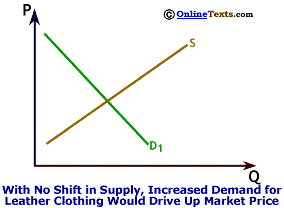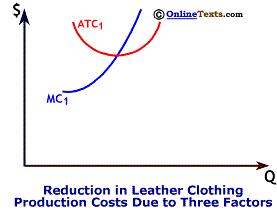

If demand increases, as shown to the right, we would expect the market price of leather clothing to rise. In fact, though, leather clothing is now cheaper than ever. This means that the increase in demand cannot be the only change in the leather clothing market in recent years.
Three significant factors have combined in the last four years to greatly increase the supply of leather, reducing the cost and shifting out the supply curve for leather clothes. These are: 1.) changes in FTC guidelines for what may be labeled "leather," 2.) increased supply of animal hides and 3.) improved leather tanning technology. We'll address each of these three factors:
1.) Changes in FTC Labeling Guidelines: Prior to 1996 the U.S. Federal Trade Commission ([Outside Econweb] FTC) only allowed the label "Leather" to be applied to "top-grain" or the outer hide of cows and pigs. This ruling was relaxed in 1996 so that any layer of any kind of animal hide can be labeled "leather." Also, it is now legal to label rat skin "genuine leather", and this rat skin need not even be top-grain. (Readers can take some comfort in the knowledge that the U.S. Department of Commerce ([Outside Econweb] DOC) recently banned the importing of clothing made from cats and dogs after it learned that some imported furs were made from these animals.)
2.) Increased supply of animal hides: In addition to the increase in available materials resulting from the relaxed labeling guidelines, increased meat consumption in the third world and trade with China, where millions of pigs are raised, has lead to a large increase in the number of animal hides available on the world market. 3.) Improved leather tanning technology: Improvements in leather tanning technology have made it possible for tanners to split most animal hides into three rather than two usable layers. Furthermore, hides that at one time would have been too scratched or otherwise damaged can now be treated so as to be acceptable for use in clothing.
Any one of these factors would increase world leather supplies, but these factors in combination have had a huge impact on world leather production. For example, the combination of better tanning technology and the relaxed labeling guidelines make it possible to obtain three layers of "leather" from a single hide. An increase in the supply of leather reduces the cost of manufacturing leather clothing causing the supply of leather clothing to increase (shift out). Even with the demand for leather clothing also increasing, if supply increases (shifts out) enough, the market price will fall. To the right we illustrate a shift in demand from D1 to D2, while at the same time supply shifts from S1 to S2, causing the equilibrium price to fall from P1 to P2 and the total quantity sold to increase all the way from Q1 to Q2.

Demand and supply analysis are sufficient to explain what has happened to the market price for leather clothing, but we can look specifically at what happened to the cost curves for leather clothing manufacturers. To the right we show three separate reductions in production costs of leather clothing as a reminder that three identifiable factors are at work. Originally, Marginal Costs were MC1 and Average Total Costs were ATC1. Leather is a Variable Cost in the production of leather clothing so a reduction in the cost of leather reduces the Marginal Cost of producing leather clothing, shifting the Marginal Cost curve to the right and downward. Since Marginal Cost is a component of Total Cost, the Average Total Cost curve shifts down and to the right as well. With all factors combined we show Marginal Costs falling from MC1 to MC2, then to MC3 and finally to MC4. Average Total Costs also fall all the way to ATC4. To illustrate the effect of falling production costs we focus on a specific production cost level, MC*. As Marginal Costs fall, the quantity of leather that can be produced at this Marginal Cost level rises from Q1 to Q4. Thus, we can see that for any Marginal Cost level at which firms choose to produce, the quantity they can produce has increased by a large amount.
We haven't considered issues of industrial structure in this article, but as you have learned (or will learn), in any industrial structure such large reductions in production costs lead to an increase in output and downward pressure on market prices. In addition to factors that have shifted out the supply of leather and thus the supply of leather clothing, clothing manufacturers have, in some cases, over-estimated consumer demand so that leather clothing inventories are high enough that prices have been further reduced.
Finally, animal rights activists have convinced some producers to stop buying leather from China and India after showing company executives films of animals being skinned alive in those countries, and have also aired some commercials to encourage consumer awareness of animal cruelty related to leather production. The first of these activities, to the extent it's successful, would tend to increase leather prices by shifting back supply; the second, to the extent it's successful, would tend to reduce prices of leather clothing by shifting back demand.
Copyright ©2001 OnLineTexts.com, Inc. - All Rights Reserved